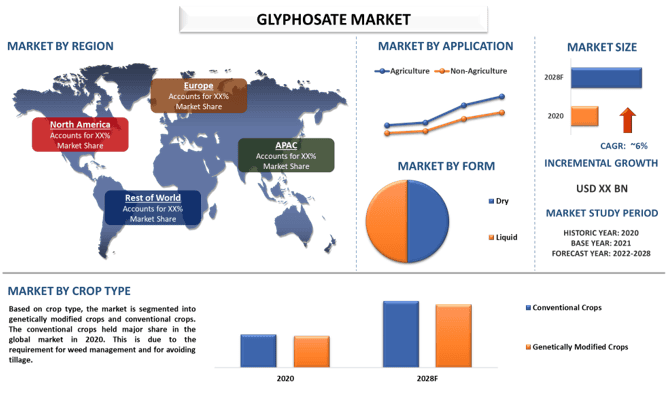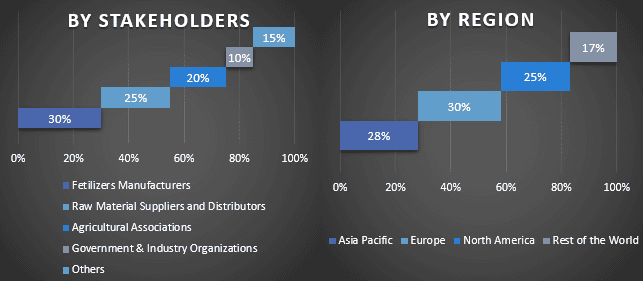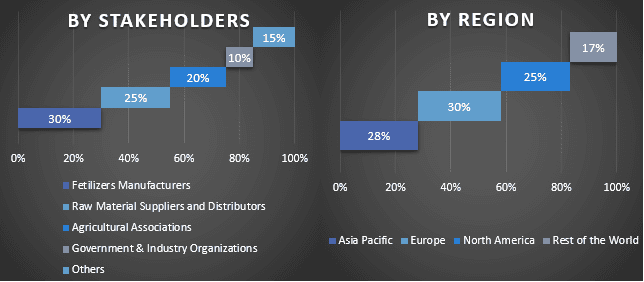
Global Glyphosate Market is expected to grow at a significant rate of around 6% during the forecast period. Glyphosate is chemical formulation for controlling weeds. It is a compound with a molecular weight of 169g that is low in toxicity. It is a glycine amino acid derivative. They work well to keep weeds under control in crops including cereals, legumes, vegetables, grains, fruits, etc. It eliminates weeds like barnyard grass, chickweed, and dandelion, among others. The surge in cultivation of fruits and vegetables across the globe has boosted the market got glyphosate globally, owing to the high susceptibility of fungal diseases. In addition, adoption of advanced farming techniques, increasing instances of fungal attacks on crops, and low costs associated with the use of fungicides as compared to other methods of control have boosted the demand for glyphosate.
Monsanto Company; Nufarm Ltd; Syngenta AG; Dow AgroSciences LLC; DuPont de Nemours Inc; Zhejiang Xinan Chemical Industrial Group Co Ltd; Jiangsu Good Harvest-Weien Agrochemical Co Ltd; Nantong Jiangshan Agrochemical & Chemicals Co Ltd.; Anhui Huaxing Chemical Industry Co Ltd; and BASF SE. are some of the key players in the market. Several M&As along with partnerships have been undertaken by these players to facilitate customers with hi-tech and innovative products/technologies.
Insights Presented in the Report
“Amongst crop type, genetically modified crops category to witness robust CAGR during the forecast period”
Based on crop type, the market is segmented into genetically modified crops and conventional crops. The genetically modified crops is expected to grow with high CAGR during the forecast period due to their associated beneficial traits, such as high yield, high quality, insect resistance, and others. The market is expected to grow on the backbone of upsurged demand from biofuel manufacturing units. The modified crops and plants are promoted as new and viable option for biofuel production for their higher yield and higher quality feedstock. Since the economies are inclined toward eco-friendly means of transportation, biofuels are expected to increasingly gain popularity and thus support the growth of the global genetically modified crops market in the future forecast years.
“Amongst application type, the agriculture to hold a significant share in the market in 2020”
On the basis of application, the glyphosate market is segmented into agriculture and non-agriculture. The agriculture category is expected to hold major share in the market in 2020. With millions of acres planted, large field crops, such as soybeans, corn, cotton, and sugar beets, have the highest total area treated and pounds applied with glyphosate. On average, 84% of glyphosate, in terms of volume, is applied to soybeans, corn, or cotton per year. These three field crops have glyphosate-resistant (GR) varieties that have been widely adopted. The average single application rate for field crops ranges from 0.72 to 1.00 lbs. a.e./acre. Thus, glyphosate remains a useful herbicide for users in agricultural settings because of its nature of broad-spectrum application, is simple to use, and is often cost-effective.
“Asia Pacific to witness high growth in the market”
The Asia-Pacific region is estimated to witness high growth in the market during the forthcoming years. The region has the highest arable land in the world with the highest crop diversity. Increased adoption of advanced agricultural practices such as zero-tillage is expected to deliver growth to the glyphosate market in the region. Although China has provided approval to grow herbicide-tolerant hybrids, the constraint remains with respect to India, which is yet to provide approvals for any genetically modified hybrid in food crops. Bt cotton is the only GM crop that is allowed in India. In 2020, the government allowed a Maharashtra-based company to conduct field trials for Bt brinjal in eight states, including Madhya Pradesh and Karnataka. The varieties to be tested were a proprietary product of the government-run Indian Agricultural Research Institute (IARI).
Reasons to buy this report:
Customization Options:
The global glyphosate market can further be customized as per the requirement or any other market segment. Besides this, UMI understands that you may have your own business needs, hence feel free to connect with us to get a report that completely suits your requirements.
1. Market Introduction
2. Research Methodology Or Assumption
3. Market Synopsis
4. Executive Summary
5. Executive Summary
6. Impact Of Covid-19 On The Glyphosate Market
7. Glyphosate Market Revenue, 2020-2028f
8. Market Insights By Crop Type
9. Market Insights By Form
10. Market Insights By Application
11. Market Insights By Region
12. Glyphosate Market Dynamics
13. Glyphosate Market Opportunities
14. Glyphosate Market Trends
15. Demand And Supply-side Analysis
16. Value Chain Analysis
17. Competitive Scenario
18. Company Profiled
19. Disclaimer
Research Methodology for the Glyphosate Market Analysis (2022-2028)
Analyzing the historical market, estimating the current market, and forecasting the future market of the global glyphosate market were the three major steps undertaken to create and analyze the adoption of glyphosates in major regions globally. Exhaustive secondary research was conducted to collect the historical market numbers and estimate the current market size. Secondly, to validate these insights, numerous findings and assumptions were taken into consideration. Moreover, exhaustive primary interviews were also conducted, with industry experts across the value chain of the global glyphosate market. Post assumption and validation of market numbers through primary interviews, we employed a top-down/bottom-up approach to forecasting the complete market size. Thereafter, market breakdown and data triangulation methods were adopted to estimate and analyze the market size of segments and sub-segments of the industry pertains to. Detailed methodology is explained below:
Analysis of Historical Market Size
Step 1: In-Depth Study of Secondary Sources:
Detail secondary study was conducted to obtain the historical market size of the glyphosate market through company internal sources such as annual reports & financial statements, performance presentations, press releases, etc., and external sources including journals, news & articles, government publications, competitor publications, sector reports, third-party database, and other credible publications.
Step 2: Market Segmentation:
After obtaining the historical market size of the glyphosate market, we conducted a detailed secondary analysis to gather historical market insights and share for different segments & sub-segments for major regions. Major segments are included in the report as type, drive type, and application. Further country-level analyses were conducted to evaluate the overall adoption of testing models in that region.
Step 3: Factor Analysis:
After acquiring the historical market size of different segments and sub-segments, we conducted a detailed factor analysis to estimate the current market size of the glyphosate market. Further, we conducted factor analysis using dependent and independent variables such as various type, drive type, and applications of glyphosates. A thorough analysis was conducted for demand and supply-side scenarios considering top partnerships, mergers and acquisitions, business expansion, and product launches in the glyphosate market sector across the globe.
Current Market Size Estimate & Forecast
Current Market Sizing: Based on actionable insights from the above 3 steps, we arrived at the current market size, key players in the global glyphosate market, and market shares of the segments. All the required percentage shares split, and market breakdowns were determined using the above-mentioned secondary approach and were verified through primary interviews.
Estimation & Forecasting: For market estimation and forecast, weights were assigned to different factors including drivers & trends, restraints, and opportunities available for the stakeholders. After analyzing these factors, relevant forecasting techniques i.e., the top-down/bottom-up approach were applied to arrive at the market forecast for 2028 for different segments and sub-segments across the major markets globally. The research methodology adopted to estimate the market size encompasses:
Market Size and Share Validation
Primary Research: In-depth interviews were conducted with the Key Opinion Leaders (KOLs) including Top Level Executives (CXO/VPs, Sales Head, Marketing Head, Operational Head, Regional Head, Country Head, etc.) across major regions. Primary research findings were then summarized, and statistical analysis was performed to prove the stated hypothesis. Inputs from primary research were consolidated with secondary findings, hence turning information into actionable insights.
Split of Primary Participants in Different Regions

Market Engineering
The data triangulation technique was employed to complete the overall market estimation and to arrive at precise statistical numbers for each segment and sub-segment of the global glyphosate market. Data was split into several segments & sub-segments post studying various parameters and trends in the areas of type, drive type, and application in the global glyphosate market.
The main objective of the Global Glyphosate Market Study
The current & future market trends of the global glyphosate market were pinpointed in the study. Investors can gain strategic insights to base their discretion for investments on the qualitative and quantitative analysis performed in the study. Current and future market trends determined the overall attractiveness of the market at a regional level, providing a platform for the industrial participant to exploit the untapped market to benefit from a first-mover advantage. Other quantitative goals of the studies include:

Customers who bought this item also bought